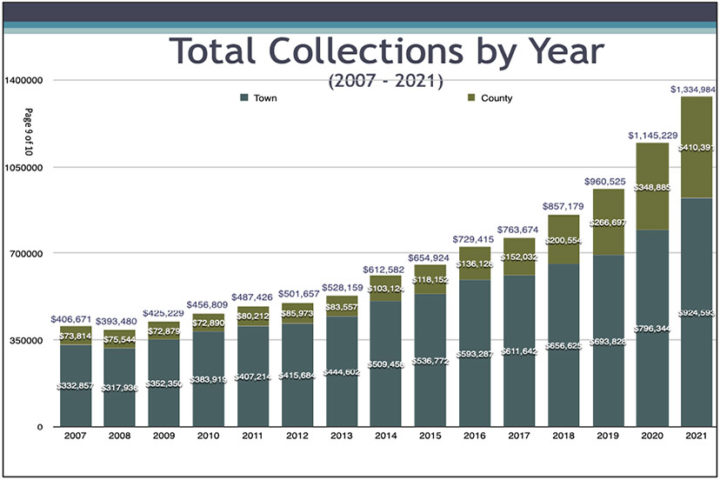The Town of Pagosa Springs has made numerous steps, over the past three years, to begin addressing the community’s housing crisis, including changes to its Land Use and Development Code (LUDC), placing a limit on the number of STRs (Short-Term Rentals) allowed within the town boundaries, and, this year, establishing a new ‘Housing Department’ within Town Hall.
Certain other Colorado communities have established permanent funding streams — typically, some type of tax — to help pay for housing programs. A few such funding streams date back ten, twenty, thirty years, and the collected revenue currently totals in the millions of dollars annually.
Here in Pagosa, the Town government and the Archuleta County government have dedicated a few thousand dollars per year to housing, allocated from fees on STRs. But the ‘Roadmap to Affordable Housing’ plan, adopted by the Town Council three years ago, suggested some specific revenue streams which, thus far, neither the Town Council nor the Board of County Commissioners have had the political will to create.
The ‘Roadmap to Affordable Housing’ was written by a local non-profit group — Pagosa Housing Partners — and that same group has been urging the Council and the BOCC to establish permanent funding for local housing programs. (Disclosure: I currently serve on PHP’s volunteer board of directors.)
Over the past month, PHP circulated a petition among town voters, and were successful in placing a measure on the April 5 municipal ballot. The measure, if approved by the town voters, would create a substantially larger fee in STRs within the town limits than what the Town currently charges, and use the revenue exclusively for housing efforts.
“Commencing June 1, 2022, the Town of Pagosa Springs shall collect a Workforce Housing Fee from Short-Term Rentals (STRs) located within Town limits, amounting to at least $150 per month for each permitted bedroom, except no Workforce Housing Fee shall be due when an STR owner resides full-time on the STR property at least nine (9) months of the year. All Workforce Housing Fees shall be dedicated to the creation and sustainability of workforce housing aimed at households earning no more than 100% of Area Median Income.”
The Town Council had discussed a similar idea last fall, but was not able to come to an agreement. So the citizens put the question on the ballot through the petition process.
More recently, the Town Council has been engaged in a debate over another source of housing program revenue: the 4.9% Lodgers Tax collected from hotels, vacation rentals, and other lodging operations located within the Town limits. When that tax was created in 2006, the Town Council created a ‘Town Tourism Committee’ to allocate the revenue for the express purpose of promoting tourism. The first year, the 4.9% Town tax combined with the County’s 1.9% tax, amounted to about $400,000.
By 2021 the total revenue had more than tripled, to more than $1.3` million.

Because the tourism industry is highly dependent in low-wage workers — the folks suffering most from our current housing crisis — the re-allocation of Lodgers Tax for housing programs was mentioned in the ‘Roadmap to Affordable Housing’ and was also recommended by the Town Planning Commission and by Pagosa Housing Partners.
In early December, the Town Council approved the first reading of Ordinance 968, which proposed to re-allocate 50% of the Town Lodgers Tax to housing programs and related infrastructure.
But during that first reading, the Council added to little words to the ordinance.
“Up to”… as in “up to 50%”. This utterly altered the reliability of the funding stream. Instead of creating a ‘permanent funding stream’ the Council had approved an ‘occasional funding stream’.
When the ordinance came before the Council on January 4 for its second reading, Council member Jeff Posey expressed just such a complaint.
“I was not here for the Pearl Harbor Day meeting on December 7, and it looks like you added the words ‘up to’.
“I would call that more than a minor change. If you say you have to spend 50% of [Lodgers Tax] on ‘X’, that’s radically different from saying you may spend up to 50% on ‘X’. I mean, as written, this means we could spend zero percent on workforce housing, and it would still meet the meaning of this ordinance.
“Which makes me wonder, why even have the ordinance? If we can spend zero percent. It seems like an unnecessary ordinance if we have the option to spend zero percent.
“If we decided that Reservoir Hill Park needs thinning, we could spend it there, instead. That’s related to tourism…
“I’m just really curious what you think about adding that language, ‘up to’…”
The Council that evening was missing one member, so the six members present engaged in a vigorous discussion about those two little words.
Eventually, Council member Mat deGraaf made a motion to approve the ordinance without the ‘up to’ wording, but the resulting 3-to-3 vote failed to produce the necessary majority.
Council member Shari Pierce then moved to approve the ordinance with the ‘up to’ wording included, and that motion also failed 3-to-3.
Ms. Pierce then suggested a definite allocation, but at a lower percentage. “Say, 40%?” But Town Attorney Clay Buchner opined that such a change would be ‘substantive’ and the approval process would need to start over with a new ‘first reading’.
So the ordinance was dead in the water, for the time being.
Council member Matt DeGuise suggested that the Council should open negotiations with the Tourism Board — a group that has consistently rejected the idea of permanently reallocating Lodgers Tax for housing programs — to get their advice on a reasonable percentage.
A report from Root Policy Research, published last August, stated that Archuleta County needs about 800 additional housing units to address the current shortage. You can download that report here. That number is mentioned on page 60.
It’s quite possible that the citizens will need to resolve this dispute with yet another petition drive.
But I still want to address the main question posed by this editorial series. What is an ‘authentic community’?

